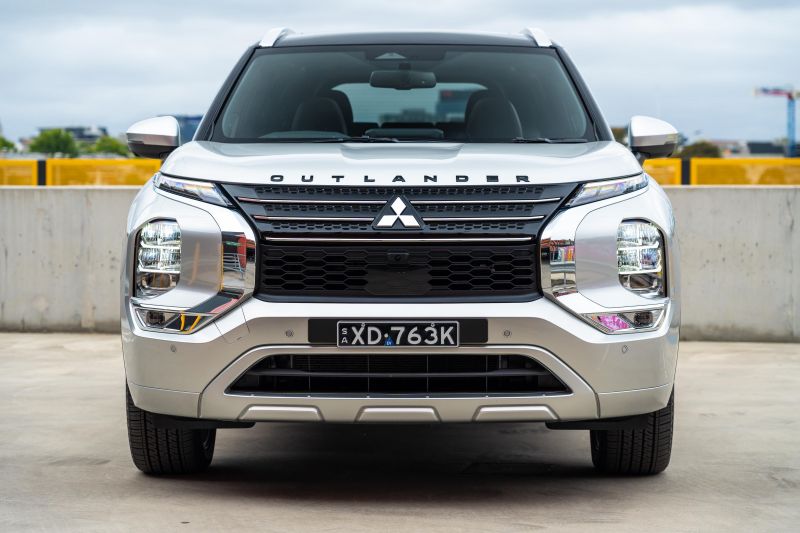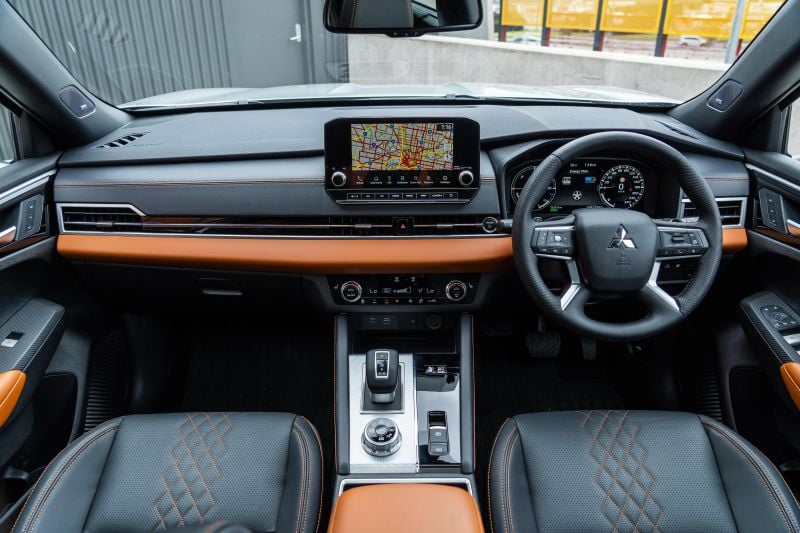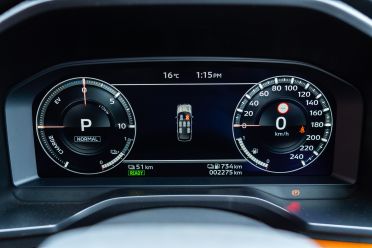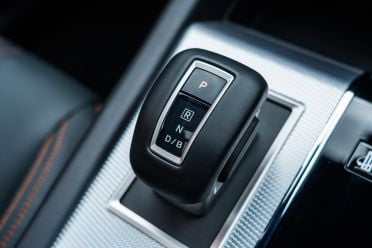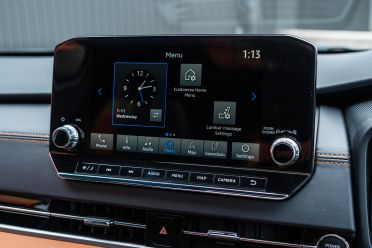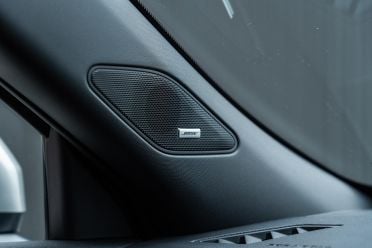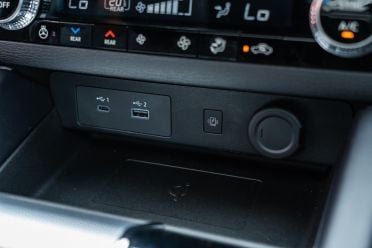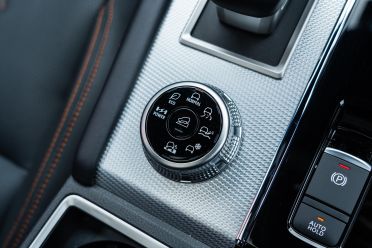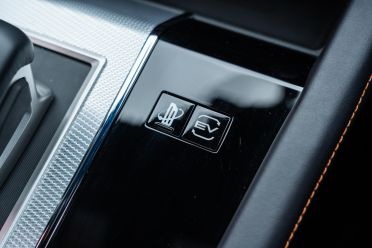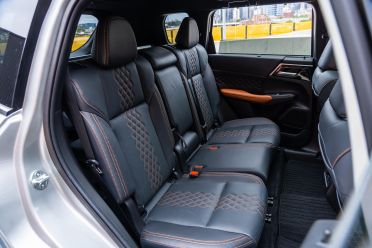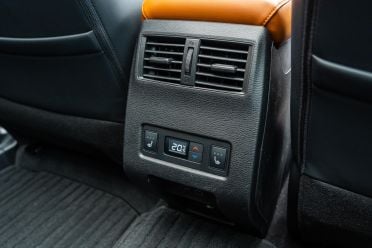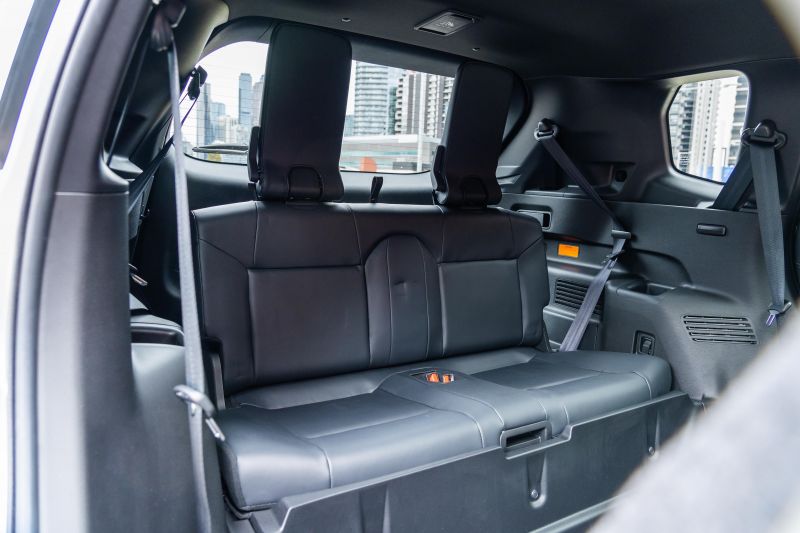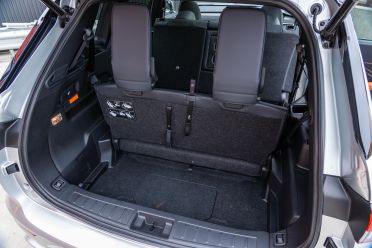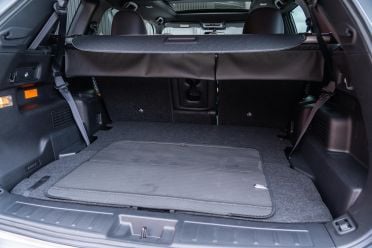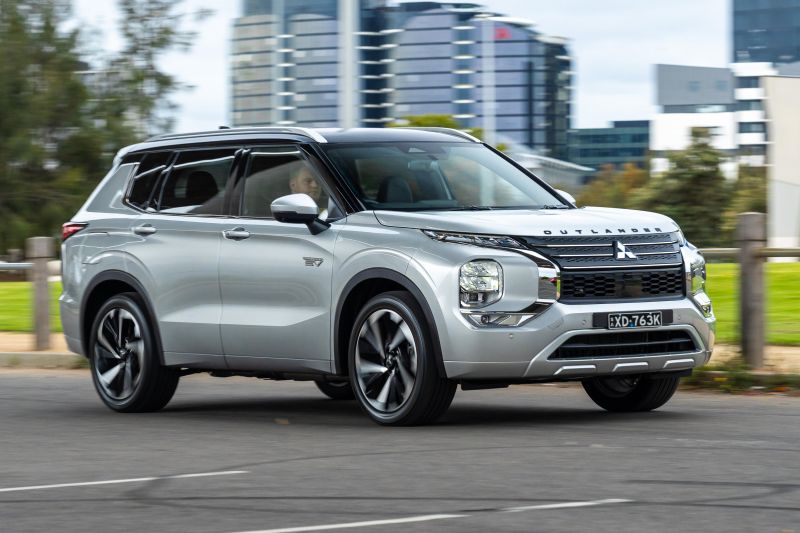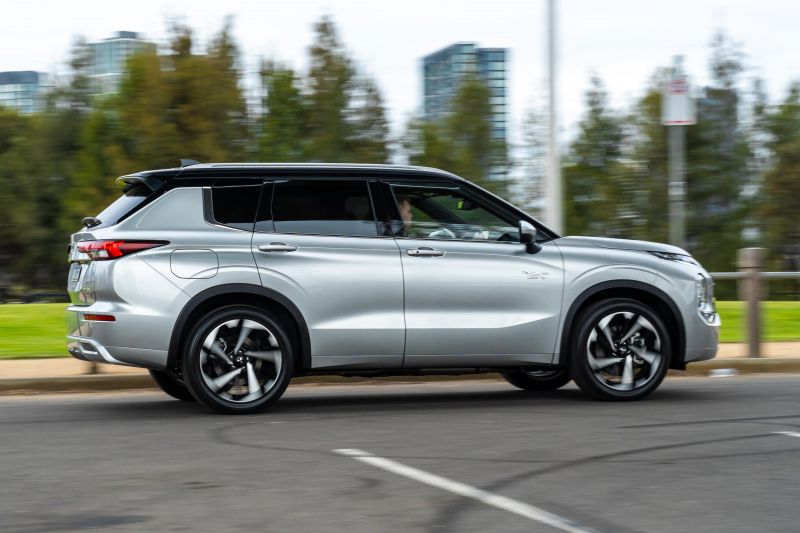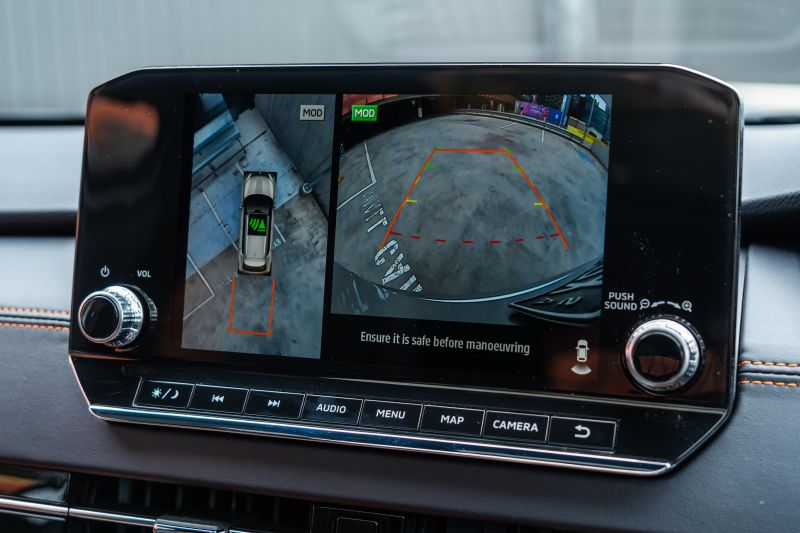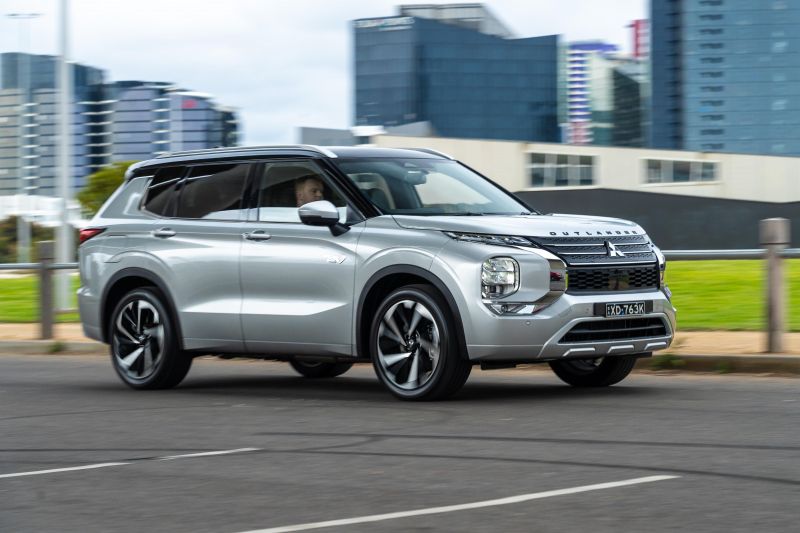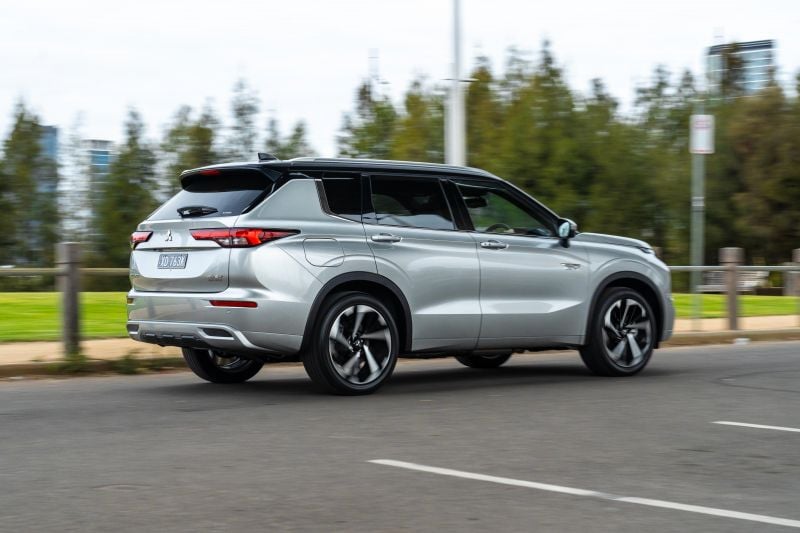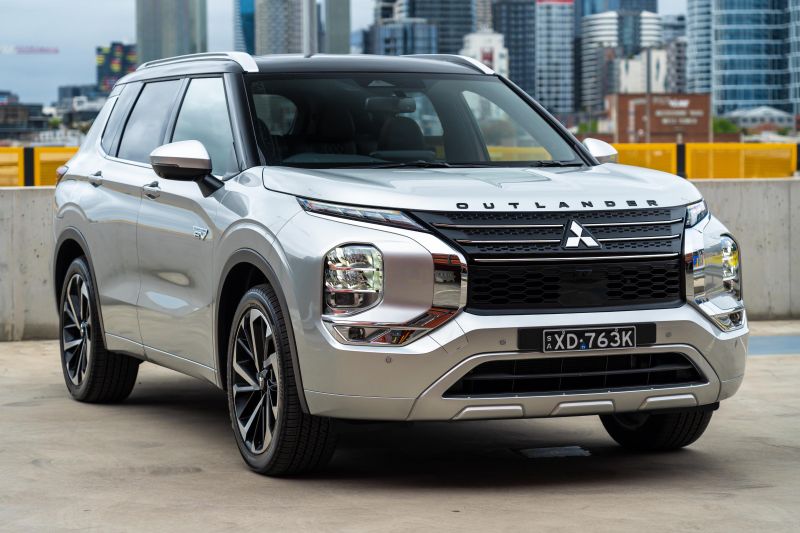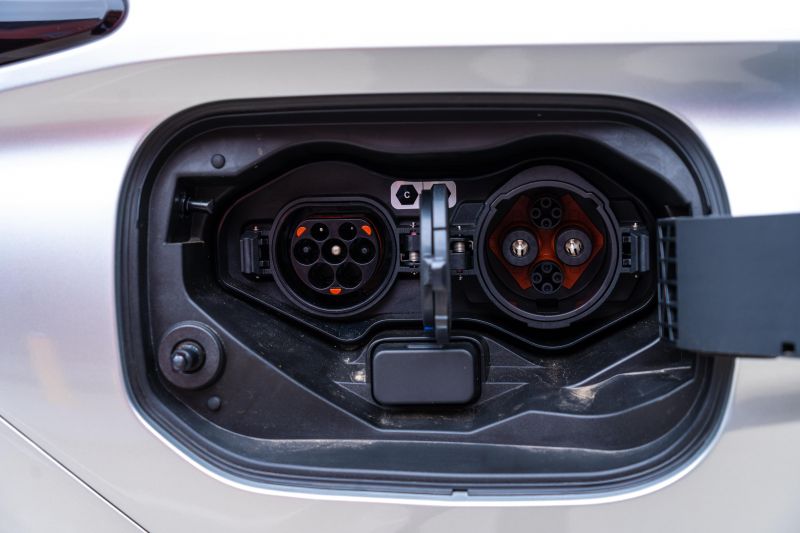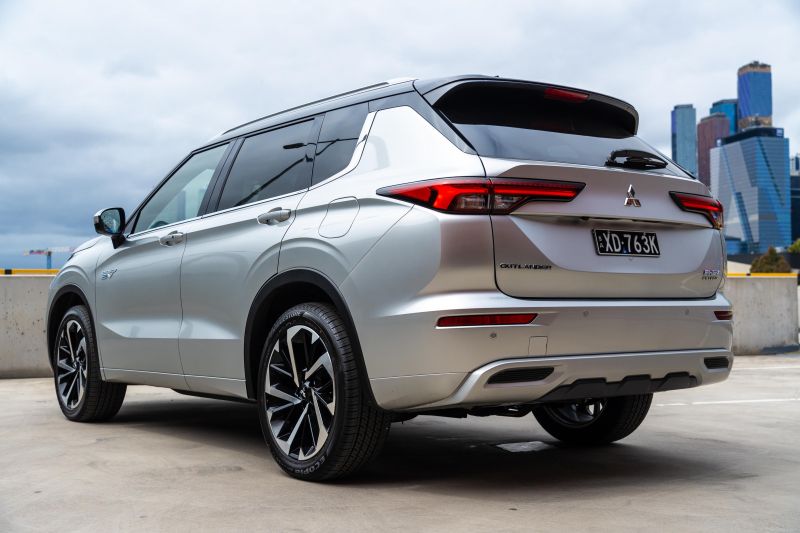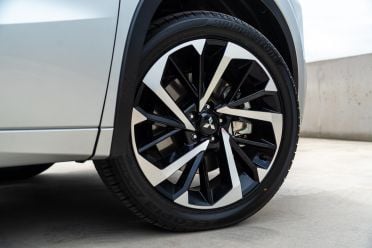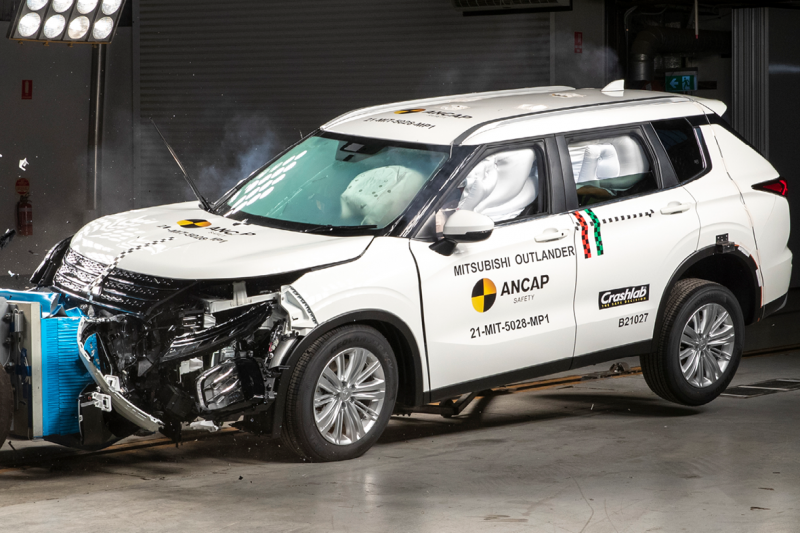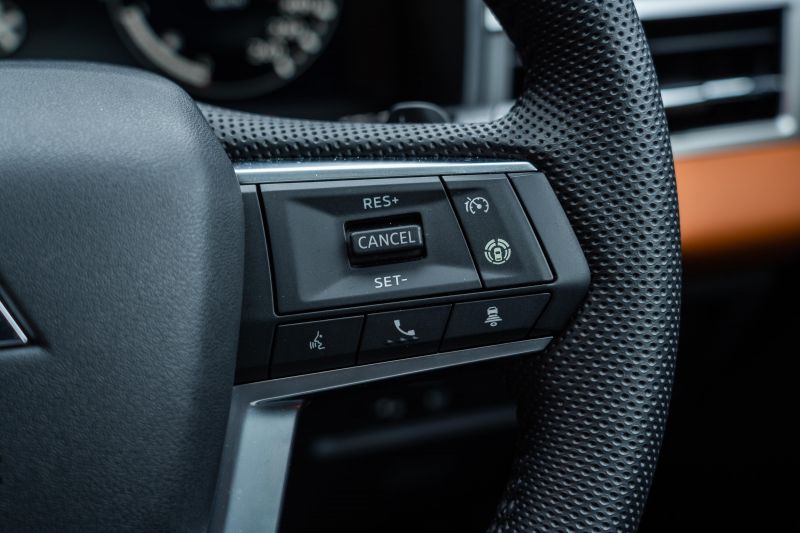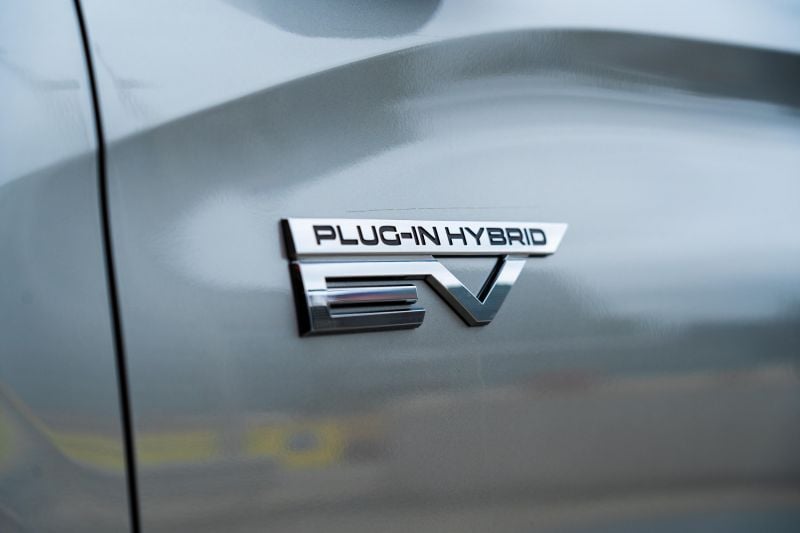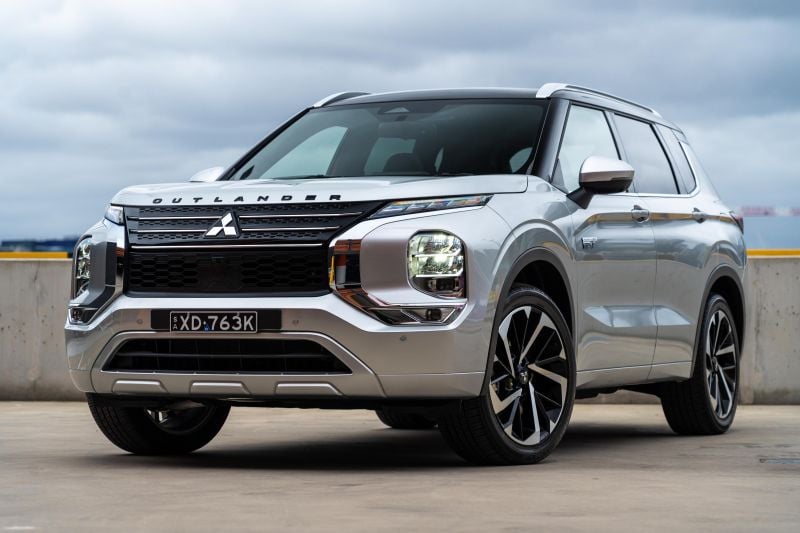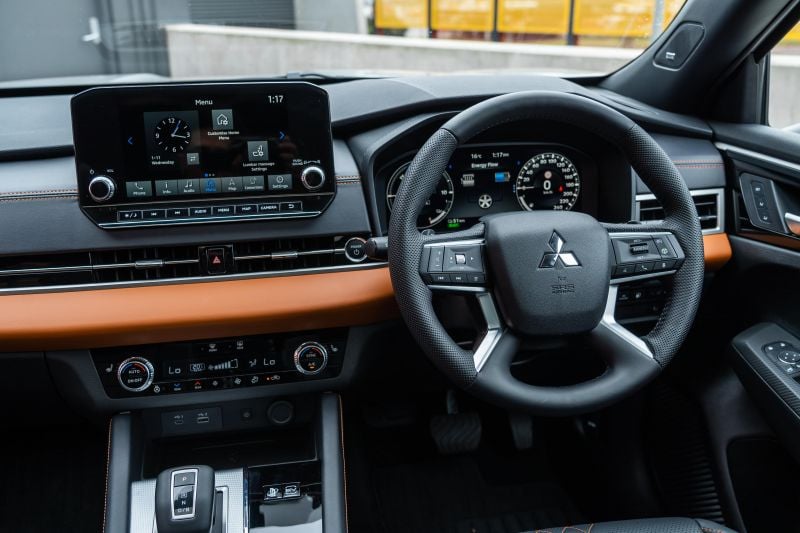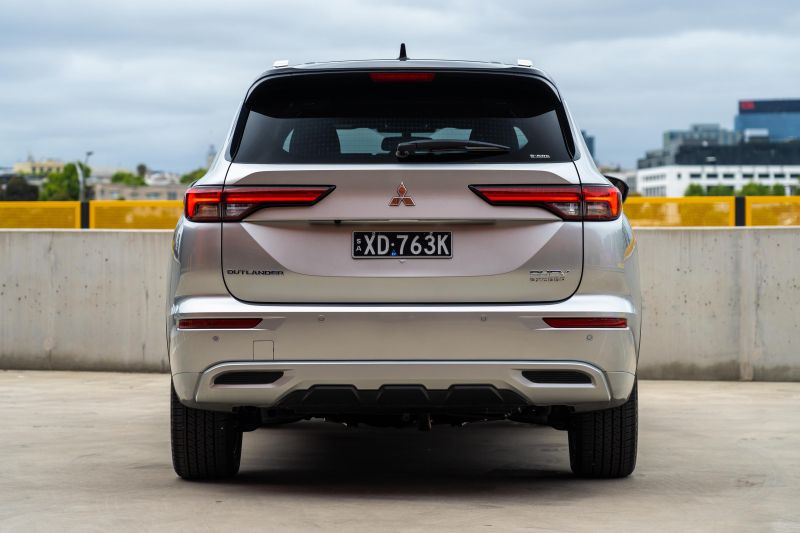Mitsubishi has been in the plug-in hybrid (PHEV) game in Australia for a considerable number of years – in fact, it launched it’s first PHEV locally in 2014. However, this powertrain technology is still only a microcosm in new car sales.
In 2023 a total of 11,212 PHEVs were sold in Australia out of a record-breaking 1.2 million cars. This equates to approximately 0.92 per cent of all new car sales during 2023.
The current-generation Mitsubishi Outlander PHEV, which is arguably the best-known PHEV offered locally, has been on sale in Australia for over a year now and it recently received a few tweaks and a higher price tag for MY24.
One of these tweaks included a new rear seat alert function across the entire range, which detects rear door use upon entry and can notify the driver with either an instrument cluster message or horn notification when they’re exiting the vehicle.
Other tweaks include LED rear fog lights, instead of halogen units, and new exterior paint colour options.
On test here is the flagship 2024 Mitsubishi Outlander PHEV Exceed Tourer with its flashy two-tone exterior paint and interior upholstery. It’s also the most expensive Mitsubishi vehicle currently on sale.
Does the Outlander PHEV form as an SUV you should actually consider in flagship Exceed Tourer form? Read along to find out.
How does the Mitsubishi Outlander fare vs its competitors?
View a detailed breakdown of the Mitsubishi Outlander against similarly sized vehicles.

Mitsubishi
Outlander
How much does the Mitsubishi Outlander cost?
- 2024 Mitsubishi Outlander ES 5-seat: $37,740
- 2024 Mitsubishi Outlander LS: $41,240
- 2024 Mitsubishi Outlander Black Edition: $42,990
- 2024 Mitsubishi Outlander LS AWD: $43,740
- 2024 Mitsubishi Outlander Aspire: $44,840
- 2024 Mitsubishi Outlander Aspire AWD: $47,340
- 2024 Mitsubishi Outlander Exceed AWD: $52,640
- 2024 Mitsubishi Outlander Exceed Tourer AWD: $55,190
- 2024 Mitsubishi Outlander PHEV ES AWD 5-seat: $57,290
- 2024 Mitsubishi Outlander PHEV Aspire AWD 5-seat: $63,790
- 2024 Mitsubishi Outlander PHEV Exceed AWD: $69,290
- 2024 Mitsubishi Outlander PHEV Exceed Tourer AWD: $71,790
All prices exclude on-road costs
To see how the Outlander compares with its rivals, line it up side-by-side with any car you want using our comparison tool.
What is the Mitsubishi Outlander like on the inside?
Walking up to the Mitsubishi Outlander Plug-In Hybrid EV there’s no immediate way differentiate this model from the petrol-powered variants apart for the PHEV badging on the front door panels and tailgate – this continues on the inside as well.
Thanks to its sought-after high ride height, this means it’s really easy to get in and out of the Outlander PHEV. You don’t need to step up or down, but can rather just step in and swivel your hips to get comfortable.
The flagship Outlander PHEV Exceed Tourer on test here comes equipped with leather seats that have a very cool-looking two-tone black and saddle tan finish.
Both front seats have a fantastic amount of electric adjustment, as well as memory. My favourite part of the driver’s seat was how much thigh support I was able to receive.
In addition, both front seats are heated, which are a treat on cool Melbourne mornings, and have a massage function. However, they are missing ventilation which is a little disappointing given this is the flagship variant.
Ahead of the driver is an incredibly thick leather-wrapped steering wheel, which feels nice in the hand and has perforations in order to allow your hands to breathe and not get too sweaty. It’s also heated.
All the buttons on the steering wheel have a tactile click or push action and are logically placed; though, the button to initially turn on the adaptive cruise control takes a bit to find and get used to. It doesn’t look like a typical cruise control icon, but is instead one that shows a car surrounded by a range of curved lines.
Behind the steering wheel is a 12.3-inch digital instrument cluster that offers high-resolution and plenty of configuration options.
The digital instrument cluster has two main screen layouts, as well as countless informative pages to choose from. Regardless of which layout, I like seeing the page that shows what the PHEV system is doing in regards to where power is being sent and when regenerative braking kicks in.
There is something that is a little frustrating is when you activate adaptive cruise control for the first time on a drive. The digital instrument cluster automatically changes to the page dedicated to adaptive cruise control. You have to manually change it back to what you want after this happens – though you can dig through menus and switch this off.
The head-up display is at least large and bright. The information it projects onto the windscreen is just enough to keep you looking ahead and not having to glance down at the instrument cluster.
Moving across the dashboard, the Outlander PHEV Exceed Tourer comes with a 9.0-inch touchscreen infotainment system that does look a little on the smaller side given this model’s ‘top of the line’ status. This isn’t helped by the large piano black bezels around the touchscreen itself.
Despite this, the touchscreen looks high-resolution and has plenty of processing power. This means it turns on quickly at startup and new pages load snappily.
The infotainment system supports both wired and wireless forms of Apple CarPlay; though, it only supports wired Android Auto.
With my iPhone 12 Pro Max connected with wireless Apple CarPlay for the entirety of my time with our Outlander Exceed Tourer, I didn’t experience any dropouts whatsoever. This is surprising as a number of cars struggle with connection when travelling through toll booths, for example.
It wasn’t perfect however; the wireless charger fried my phone a bit and caused it to overheat a number of times. This likely means the coils inside the Qi charger didn’t properly align with my phone, which is disappointing.
The Outlander PHEV Exceed Tourer’s touchscreen infotainment system also comes with in-built satellite navigation, which is easy enough to use. Despite this I found I used Google Maps with smartphone mirroring instead.
Looking around the interior of our tester there are a wider range of black and saddle tan elements, like the seats. There are also quite a number of soft-touch materials which makes the car feel surprisingly high-end, which it should given the asking price.
Piano black elements still pop up disappointingly on different surfaces in the Outlander PHEV Exceed Tourer’s interior – as we all know this finish gets grimy and scratched very easily.
There’s also a faux silver metal section next to the gear selector which does look a tad kitschy.
The Outlander PHEV Exceed Tourer comes standard with a panoramic glass sunroof which helps create an airy ambience to the cabin. It also opens up a fair way which allows the cabin to vent hot air quicker.
Moving to the second row, there’s plenty of space when the seats are pushed all the way back. Leg and shoulder space are fine; though, head room is a little compromised due to the sunroof.
The amount of leg room in the second row will be reduced when you inevitably pull it forward to allow for more space for those in the third row, however.
In terms of second-row amenities there are centre console-mounted air vents, heated outboard seats, as well as a fold-down centre armrest with cupholders.
If you want to erect the third row of seats, the best place to do this is from the boot. There are number of steps to this process but it doesn’t take too long to learn.
Once the third row seats are erected you’ll notice they are incredibly thin and have arguably the world’s funniest looking headrests – why are they so long?
The third row is definitely a kids-only or emergency space as adults won’t fit comfortably whatsoever. I gave it a crack at a leggy 182cm and found my head was severely crooked and my legs were splayed at extremely awkward angles in order to fit.
Around the back the Outlander PHEV Exceed Tourer has a powered tailgate with a hands-free kick function that’s extremely helpful if you’ve got your hands full.
Once the boot is open you’ll notice there’s not very much space (161 litres) if all three rows of seats are upright. Thankfully this becomes more usable 461 litres with the third row of seats folded down.
There are some cool hard-shell bags with velcro bottoms for the Outlander PHEV’s charging cables, which allow them to be stuck onto the boot floor or a seat backrest. This ensures they don’t slide around and they can be tucked out of the way.
Due to the location of the Outlander PHEV’s high-voltage battery, there’s no spare tyre whatsoever. There is a tyre repair kit however, which is nice to have but is nowhere near as helpful as a proper spare wheel.
What’s under the bonnet?
The Mitsubishi Outlander is available with either a conventional 2.5-litre naturally aspirated four-cylinder petrol engine, or like our tester, a plug-in hybrid (PHEV) powertrain with a 2.4-litre four-cylinder petrol engine, twin electric motors and a lithium-ion battery.
| Model | Mitsubishi Outlander Plug-In Hybrid |
|---|---|
| Engine | 2.4-litre naturally aspirated Atkinson-cycle 4cyl petrol |
| Engine power | 98kW |
| Engine torque | 195Nm |
| Electric motors | Front- and rear-mounted electric motors |
| Front electric motor power | 85kW |
| Rear electric motor power | 100kW |
| Total system power | 185kW |
| Total system torque | 450Nm |
| Transmission | Single-speed transaxle |
| Battery | 20kWh lithium-ion battery (350V) |
| Driven wheels | All-wheel drive |
| Weight | 2145kg (kerb) |
| Fuel economy (claim) | 1.5 litres per 100km |
| Fuel economy (observed) | 3.3 litres per 100km (68 per cent in EV mode) |
| Fuel tank size | 56 litres |
| Fuel requirement | 91 RON |
How does the Mitsubishi Outlander drive?
It’s worth flagging straight away there are a number of different ways to drive the Outlander PHEV, depending on how you charge the car.
Throughout my time with our vehicle I tried out as many different ways to drive, charge and experience the Outlander PHEV as possible, which means it might not be directly comparable to how an everyday person would use their car.
Starting up the Outlander PHEV is largely a silent affair with a press of the power button producing a couple of chimes. That’s it, you’re ready to go.
It does take a little bit to get used to the funny gear selector which requires you to either push or pull it to select either drive or reverse – am I wrong for thinking it’s a little bit like a Bop It?
Once you get moving you’ll realise the Outlander PHEV has a really high bonnet, which makes it feel larger than it is. There’s also a “king of the road” vibe, which is very sought after among SUV buyers.
The Outlander PHEV is punchy from takeoff due in part to its dual electric motors. This is because the full amount of the electric motor’s torque is available from standstill.
You’ll easily be pulling ahead of traffic at the lights and that kind of rapid acceleration will continue in all urban and metropolitan settings. This is really surprising given the SUV’s 2.1-tonne kerb weight.
If you do really punch the accelerator, the Outlander PHEV’s petrol engine can switch on but doesn’t necessarily make the acceleration happen any faster. The engine will also stay on for a while after you’ve punched the accelerator to properly warm up.
In low-speed scenarios it’s incredibly easy to notice how light the steering is. It’s almost too light which can make it a little devoid of feeling.
An upside of this; however, is it makes the Outlander PHEV easy to park. This is supplemented by the front and rear parking sensors and surround-view camera that is of decent quality.
Something funny about the Outlander PHEV is when it’s in EV mode there’s a cute beeping noise when reversing. You can only faintly hear the noise from inside the cabin, but its purpose is to alert nearby pedestrians.
The Outlander PHEV doesn’t come with a one-pedal driving function; though, there is a setting that amplifies the regenerative braking. Some of my colleagues really like this function, but I found it to be jarring and jerky as you still need to depress the brake pedal to come to a complete stop.
The brake pedal also has a lot of travel, which makes it hard to gauge how much pressure you need to input to properly stop. I much preferred the regular regenerative braking mode, which is still strong enough and feels like a more natural and progressive stop.
In EV mode the Outlander PHEV is extremely quiet. There are the odd few electrical whirs but that’s to be expected and something you notice more when there’s a lack of engine noise.
Thanks in part to its larger 20kWh battery pack, there’s an abundance of EV-only range. When fully charged the trip computer frequently read out EV-only range figures around 80km; though, depending on how I drove, this almost extended in the real world to 100km!
This amount of EV-only range is fantastic as many people would be able to drive to and from work completely on electric power. It’s worth noting if you are only using EV mode you’re pretty much lugging around a petrol engine and its components for no reason.
The Outlander PHEV will also remain in EV mode as much as possible. Even when the trip computer is reading zero EV range left there appears to be a bit of charge left to keep the petrol engine switched off when stationary.
When the petrol engine does switch on it transitions super seamlessly. If you weren’t paying attention you mightn’t even know the petrol engine has turned on because it’s so quiet.
Despite having rapid EV acceleration, the sporty vibe surrounding the Outlander PHEV unravels once you hit some rough or twisty roads. The suspension tune is a little awkward at low speeds, making the car feel cumbersome and floaty.
This feeling is made even worse at higher speeds. Over certain bumps it feels like you leave the driver’s seat and the third row seats – which aren’t properly latched – as you bounce up and down.
The Outlander PHEV also feels like it falls over itself at higher speeds around corners – this is when the SUV’s 2.1-tonne kerb weight is most apparent.
Depending on the battery charge, the Outlander PHEV can still be in EV mode at highway speeds. This is when electric motors are at their most inefficient, so expect to see the claimed EV range quickly plummet.
To negate this there are a bunch of other EV-related modes. The ‘Save’ mode runs the petrol engine in order to keep the battery pack charge at the same level. If you’re strategic with how you use this mode, you can maximise the total distance the Outlander PHEV can go on a single tank of petrol and full battery pack.
There’s also a ‘Charge’ mode that uses the petrol engine to not only power the wheels but charge up the battery. This mode can be handy if you have no proper way to charge the Outlander PHEV, but it’s definitely not the most efficient way.
When I was trying out the ‘Charge’ mode in the Outlander PHEV I found the claimed fuel consumption skyrocketed all the way to 10 litres per 100km. Eeek…
I had a similar feeling when driving the Outlander PHEV without any charge left in the battery and more or less driving it like a regular hybrid. I was averaging around 6.0 litres per 100km, which goes to show how heavy the electrical components must be.
When the Outlander PHEV’s battery pack is low the petrol engine typically acts as a generator for the battery to power the electric motors; however, it can directly power the wheels if needed. This is more prominent at higher speeds.
In these kinds of situations the car still has enough power; though, it’s nowhere near as responsive as it is at lower speeds in EV mode. You need to think carefully about overtaking because you could get caught out.
In terms of charging, the Outlander PHEV can be AC charged using a Type 2 plug, or DC fast-charged using a CHAdeMO port.
Mitsubishi claims fully charging the Outlander PHEV’s battery pack using a 240V, 8A-10A socket takes around 9.5 hours. At a DC fast-charger on the other hand the car’s battery pack can be fully recharged in 38 minutes.
On the safety front, the Outlander PHEV’s adaptive cruise control generally works fine; though, it can overreact and slam on the brakes when a car pulls ahead of you. I completely understand the system is trying to keep me safe, but I wish it was a little more subtle about the braking.
The lane centring function as part of the adaptive cruise control system on the other hand is fantastic. I found this really surprising as I typically despise these kinds of systems and never use them – it doesn’t randomly tug at the steering wheel like some lane centring systems can do.
The last thing I’ll mention in this section is that the adaptive LED headlights on this Outlander PHEV Exceed Tourer are great. They allow for high beam to be on as much as possible when it’s dark, which in rural and regional settings can make seeing animals that are about to run onto the road a lot easier.
What do you get?
Outlander ES highlights:
- 18-inch alloy wheels
- Automatic headlights
- Automatic high-beam
- LED headlights
- Full-size alloy spare wheel (Petrol)
- Tyre repair kit (PHEV)
- 7.0-inch digital instrument cluster
- 12.3-inch digital instrument cluster (PHEV)
- 8.0-inch touchscreen infotainment system
- 9.0-inch touchscreen infotainment system (PHEV)
- Wireless Apple CarPlay (PHEV)
- Wired Apple CarPlay, Android Auto
- DAB+ digital radio
- Cruise control
- 6-speaker sound system
- Two USB inputs
- Dual-zone climate control
- 5 drive modes
- Normal, Eco, Tarmac, Gravel, Snow (Petrol)
- 6 drive modes
- All five petrol drive modes + EV mode (PHEV only)
- Electric parking brake
- Auto hold with memory
- Keyless start
- Paddle shifters
- Driver side window one-touch up/down
- 5 seats
- Cloth seat upholstery
- Driver’s seat manual adjustment with manual lumbar support
- Front passenger’s seat manual adjustment
- Second row recline adjustment
- Rear seat alert function
- Mode 3 charging cable (PHEV only)
- Mode 2 AC charging cable (PHEV only)
Outlander LS adds:
- Space-saver spare wheel
- Rain-sensing wipers
- LED front fog lights
- Privacy glass
- Silver roof rails
- 9.0-inch touchscreen infotainment system
- Wireless Apple CarPlay
- Satellite navigation
- Wireless phone charger
- 2 x rear USB ports
- Keyless entry
- Leather-wrapped steering wheel
- Leather-wrapped shifter
- Auto-dimming rear-view mirror
- Seven seats
- Second-row slide and recline adjustment
Outlander Black Edition adds:
- 20-inch black alloy wheels
- Black front and rear bumper
- Black door mirrors
- Black grille
- Black headlining
- Black gearshift panel
- Microsuede seat upholstery with synthetic leather bolsters
- 6-way power driver’s seat with electric lumbar support
- B and C-pillar garnishes
- Heated front seats
- Removes roof rails
Outlander Aspire adds (over LS):
- 20-inch two-tone alloy wheels
- LED headlights with automatic levelling
- Adaptive Driving Beam
- Power tailgate
- Head-up display
- Surround-view camera
- 5 seats (PHEV only)
- Microsuede seat upholstery with synthetic leather bolster
- 6-way power driver’s seat with electric lumbar support
- Heated front seats
- 240V/1500W power outlets (PHEV only)
Outlander Exceed adds:
- Front LED sequential indicators
- Panoramic sunroof with front tilt/slide
- Hands-free power tailgate
- 12.3-inch digital instrument cluster
- 10-speaker Bose premium sound system
- Tri-zone climate control
- Pull-up rear door sunshades
- Illuminated front door trims
- Aluminium gearshift trim panel
- Heated steering wheel
- Leather upholstery (black or grey)
- 6-way power front passenger’s seat incl. lumbar support
- Front seat memory
- MI-PILOT driving assistant
- Traffic Jam Assist
- Lane Keep Assist (steering control assistance)
- Speed Limit Assistance
Outlander Exceed Tourer adds:
- Two-tone exterior paint
- Front seat massage function
- Two-tone leather upholstery
- Rear seat heating
Is the Mitsubishi Outlander safe?
The Mitsubishi Outlander and Outlander PHEV have a five-star ANCAP safety rating based on testing conducted in 2022.
They received an adult occupant protection rating of 83 per cent, a child occupant protection rating of 92 per cent, a vulnerable road user protection rating of 81 per cent, and a safety assist rating of 83 per cent.
Standard safety features include:
- 8 airbags
- Autonomous emergency braking (AEB)
- Rear AEB
- Forward collision warning
- Moving object detection
- Lane departure warning
- Lane-keep assist
- Emergency lane assist
- Blind-spot monitoring
- Rear cross-traffic alert
- Adaptive cruise control
- Driver attention alert
- Traffic sign recognition
- Rear-view camera
- Front and rear parking sensors
- Rear seat alert function
Further up the range, the Outlander Exceed and Exceed Tourer petrol and PHEV models pick up Mitsubishi’s MI-PILOT driving assistant.
This adds Traffic Jam Assist (adaptive cruise control that re-engages after a complete stop), lane-keep assist (using steering control assistance rather than wheel braking), and speed limit assist (adaptive cruise control that matches the Outlander to the indicated speed limit).
The steering wheel in these grades features touch sensors to handle MI-PILOT engagement, and will disengage the system when the driver’s grip is not detected, when indicators are on, or when windscreen wipers are continuously operated at their highest speed.
How much does the Mitsubishi Outlander cost to run?
The 2024 Mitsubishi Outlander PHEV is covered by a standard five-year, 100,000km warranty, which can be extended to 10 years/200,000km if you service within Mitsubishi’s dealer network.
The Outlander PHEV’s high-voltage battery pack is also covered by an eight-year or 160,000km warranty.
Logbook servicing is required every 15,000km or 12 months, and the first ten services are capped at the following:
| Service | |
|---|---|
| 12 months/15,000km | $349 |
| 24 months/30,000km | $449 |
| 36 months/45,000km | $399 |
| 48 months/60,000km | $449 |
| 60 months/75,000km | $399 |
| 72 months/90,000km | $799 |
| 84 months/105,000km | $449 |
| 96 months/120,000km | $799 |
| 108 months/135,000km | $449 |
| 120 months/150,000km | $899 |
CarExpert’s Take on the Mitsubishi Outlander
The Mitsubishi Outlander PHEV is complex vehicle that can be driven and charged in a multitude of different ways.
It has an innovative powertrain that can take a lot to properly understand its capability and flexibility. If driven and charged in a certain way it can be incredibly efficient.
For a lot of people I’d argue plug-in hybrids can serve as perfect cars given they can complete their entire daily commute on EV mode during the week, and yet still tackle longer trips thanks to the petrol engine on the weekend.
If you only have one car in your family and your usage pattern is like this, it could be your sort of vehicle.
Despite this, it’s still hard to shake the fact that when you’re driving on EV mode you’re lugging around a petrol engine for no reason. The same goes for when you’re driving using the petrol engine with an empty battery pack.
There’s also the initial price premium that comes with buying a plug-in hybrid.
Our Outlander PHEV Exceed Tourer tester is almost $17,000 more expensive than its non-electrified counterpart, which would likely take years (if not decades) to recuperate.
If you’re deadset on buying an Outlander PHEV and can make a plug-in hybrid work with your lifestyle, I’d be hesitant to fully recommend the flagship Exceed Tourer variant. Over $70,000 for a Mitsubishi is a lot of money and one of the few things it gains over the Exceed is a two-tone interior.
Instead I’d urge to look closer at the entry-level Outlander PHEV ES or Aspire variants which have prices more closely aligned with top-spec petrol variants.
Click the images for the full gallery
BUY: Mitsubishi Outlander
MORE: Everything Mitsubishi Outlander

